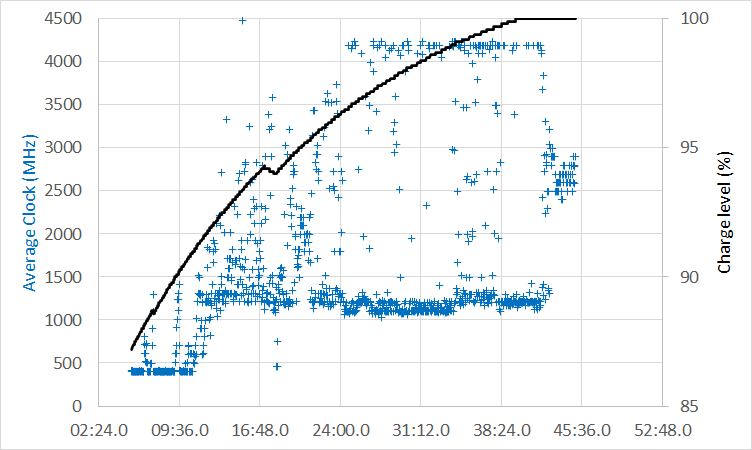I ran geekbench under 3 conditions as a test:
I start with a freshly rebooted computer, no extra programs running in the background except
-
i7z to monitor cpu freqs
-
htop to monitor cpu usage across all cores
-
psensor to monitor CPU and system temperatures
-
geekbench5 the test program
Condition 1: Fully charged battery, plugged in, battery not showing as charging.
Trial 1: Framework Laptop - Geekbench Browser

Trial 2: Framework Laptop - Geekbench Browser

Trial 3: Framework Laptop - Geekbench Browser

Condition 2: Unplugged, started just after running the test from above, so 100% charge and not charging
Trial 1: Framework Laptop - Geekbench Browser

Trial 2: Framework Laptop - Geekbench Browser

Trial 3: Framework Laptop - Geekbench Browser

Condition 3: Plugged back in, after running the test above. Starting battery level was 95%
Trial 1: https://browser.geekbench.com/v5/cpu/10403872 96% charge

Trial 2: Framework Laptop - Geekbench Browser 98% charge

Trial 3: Framework Laptop - Geekbench Browser 99% charge

The results are very interesting. The best performer was unplugged, on battery, the second best was plugged in, fully charged battery, and the worst performer was plugged in, charging battery.
Some other observations:
- When I was running the test unplugged, starting from a full charge, I noticed in i7z that the frequencies were most consistently high, and on all cores simultaneously.
- I did not utilize the iGPU at all during these tests, though I imagine it would siphon off power from the CPU which may cause the CPU to downclock further.
I’m going to test ones more when the battery is showing “100% charged” but still “recharging,” and then again right after it no longer shows that it’s recharging. If I don’t see anything interesting, I won’t post the results unless someone asks me to because I’ve spammed this thread enough with data. I have a feeling that the results are going to be the same as the first set of test conditions posted above.
The trend seems pretty clear, charging the battery is taking away power from the CPU to do tasks. I don’t know if this is an issue with the firmware on the laptop, or with how my OS is configured. If someone with windows can chime in and post their results.
Edit:
Trial 4: 100% charged, battery reports “plugged in, still discharging” despite not going down in charge.

If anyone wants any detailed system configuration info i’d be more than happy to provide it if asked, and you tell me what you need and how to get it.
Edit:
Reading up more about CPU frequency governors on the arch wiki, I came across this:
https://wiki.archlinux.org/title/CPU_frequency_scaling#BIOS_frequency_limitation
specifically referring to BIOS Frequency Limitation. Perhaps the BIOS is telling the OS to limit the frequency when this down-clocking issue is occurring?
















